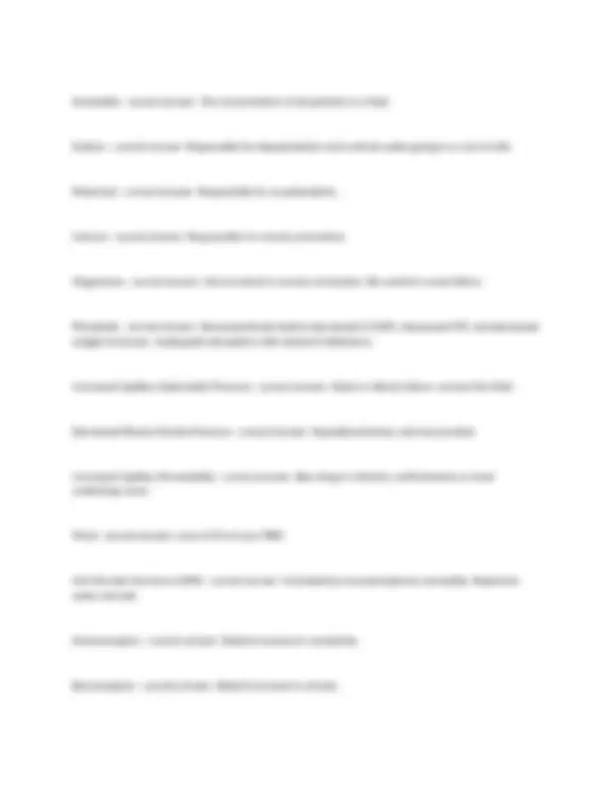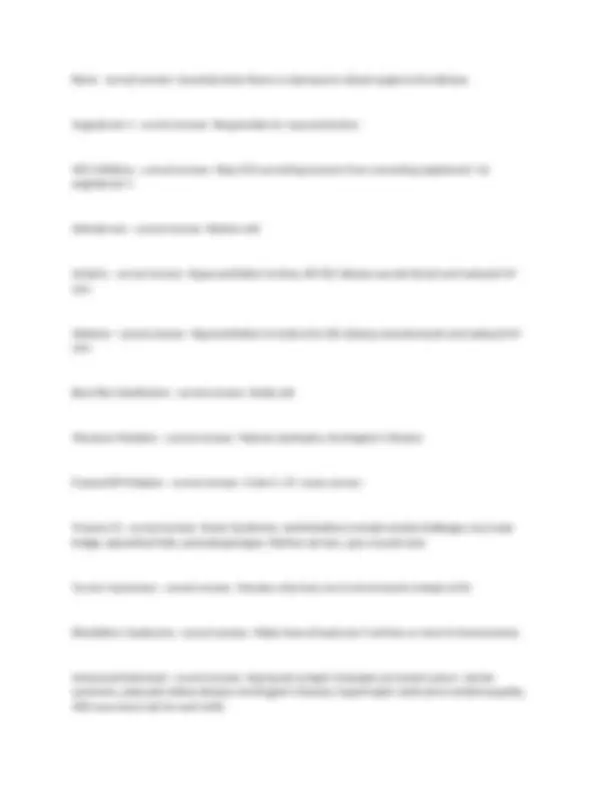





Study with the several resources on Docsity

Earn points by helping other students or get them with a premium plan


Prepare for your exams
Study with the several resources on Docsity

Earn points to download
Earn points by helping other students or get them with a premium plan
Community
Ask the community for help and clear up your study doubts
Discover the best universities in your country according to Docsity users
Free resources
Download our free guides on studying techniques, anxiety management strategies, and thesis advice from Docsity tutors
An exam review for an advanced pathophysiology course, covering a wide range of topics related to human physiology and disease processes. The exam covers key concepts such as cell structure and function, transport mechanisms, energy production, fluid and electrolyte balance, genetic disorders, and cardiovascular regulation. The detailed explanations and correct answers provided suggest this document could be a valuable study resource for students preparing for an exam in this subject area. The comprehensive nature of the content and the focus on testing understanding of fundamental pathophysiological principles make this document potentially useful not only for exam preparation, but also for reinforcing core knowledge in advanced nursing or medical curricula.
Typology: Exams
1 / 5

This page cannot be seen from the preview
Don't miss anything!




Sodium - correct answer -Main ECF ion. Potassium - correct answer -Main ICF ion. Mitochondria - correct answer -Organelle that produces ATP. Ribosomes - correct answer -Organelles responsible for protein synthesis. Lysosomes - correct answer -Organelles that degrade and recycle waste. Peroxisomes - correct answer -Organelles that break down chemicals into H202, produces free radicals. Golgi Apparatus - correct answer -Organelle responsible for packaging and distribution. Smooth Endoplasmic Reticulum - correct answer -Organelle that synthesizes steroids and detoxification. Tight Junction - correct answer -Impermeable junction; strength. Gap Junction - correct answer -Junction that allows for conductivity, synchronizes contractions of cardiac muscle through ionic coupling. Desmosomes - correct answer -Junctions that hold cells together by continuous bands or belts of epithelial sheets or button-like points of contact. Diffusion, Facilitated Diffusion, and Osmosis - correct answer -Non-energy forms of transport.
Active Transport - correct answer -Energy-requiring movement of molecules across a membrane, example is Na/K pump. Hypotonic Fluid - correct answer -Causes cells to swell. Hypertonic Fluid - correct answer -Causes cells to srhink. 36 ATP - correct answer -How many ATP are produced in aerobic respiration? 2 ATP - correct answer -How much ATP can anaerobic respiration make? Hypoxia - correct answer -#1 cause of cellular injury. Lactic Acid - correct answer -Indication of cell death. Build up leads to metabolic acidosis. Reactive Oxidative Stress - correct answer -Caused by free radicals produced by peroxisomes. Antioxidants such as fresh fruits and vegetables give an electron to an unpaired molecule. Hemosiderosis - correct answer -Too much iron in tissues. Acetaldehyde - correct answer -An intermediate in alcohol metabolism. Atrophy - correct answer -Thymus gland, muscle wasting. Hypertrophy - correct answer -Muscle growth, CHF. Hyperplasia - correct answer -Liver cell regeneration, endometrial. Metaplasia - correct answer -Barrets Esophagus, bronchial changes d/t smoking. Reversible!
Renin - correct answer -Secreted when there is a decrease in blood supply to the kidneys. Angiotensin II - correct answer -Responsible for vasoconstriction. ACE Inhibitors - correct answer -Stop ACE converting enzyme from converting angiotensin I to angiotensin II. Aldosterone - correct answer -Retains salt. Acidosis - correct answer -Hyperventilation to blow off C02; kidneys excrete bicarb and reabsorb H+ ions. Alkalosis - correct answer -Hypoventilation to hold onto C02; kidneys excrete bicarb and reabsorb H+ ions. Base Pair Substitution - correct answer -Sickle cell. Missense Mutation - correct answer -Mytonic dystrophy; Huntington's Disease Frameshift Mutation - correct answer -Crohn's; CF; some cancers. Trisomy 21 - correct answer -Down Syndrome; manifestations include mental challenges, low nasal bridge, epicanthal folds, protruding tongue, flat/low set ears, poor muscle tone. Turner's Syndrome - correct answer -Females only have one X chromosome instead of XX. Klinefelter's Syndrome - correct answer -Males have at least one Y and two or more X chromosomes. Autosomal Dominant - correct answer -Expressed as big D. Examples are breast cancer, marfan syndrome, polycystic kidney disease, Huntington's Disease, hypertrophic obstructive cardiomyopathy. 50% recurrence risk for each child.
Autosomal Recessive - correct answer -Expressed as small d. Must be homozygous (dd) to express disease. Examples are CF, tay sachs, PKU, Wilson Disease, hemochromatosis, thalassemias.